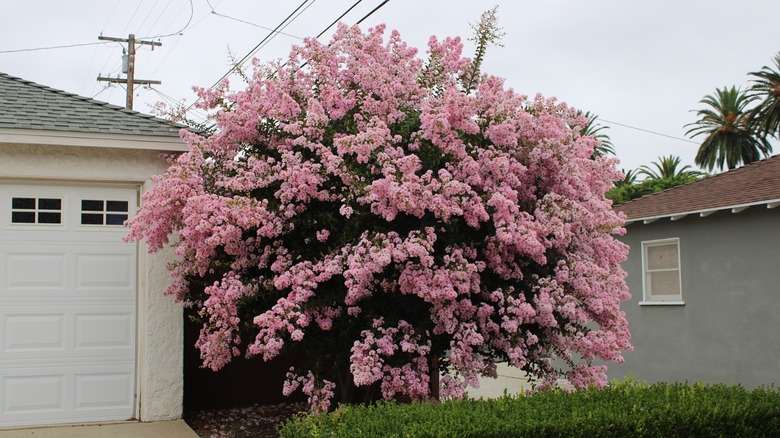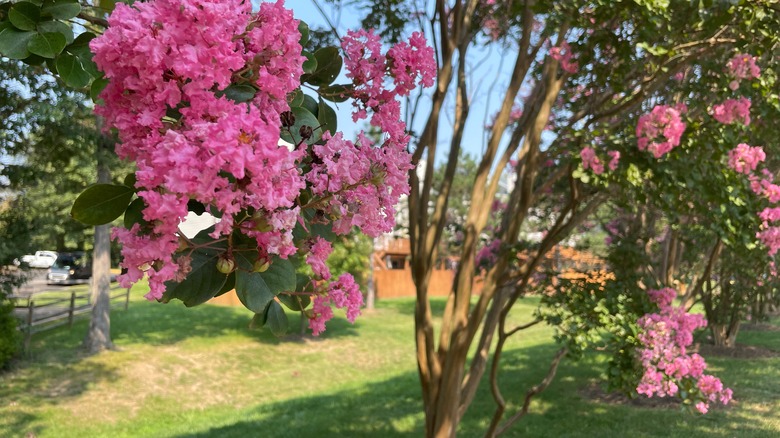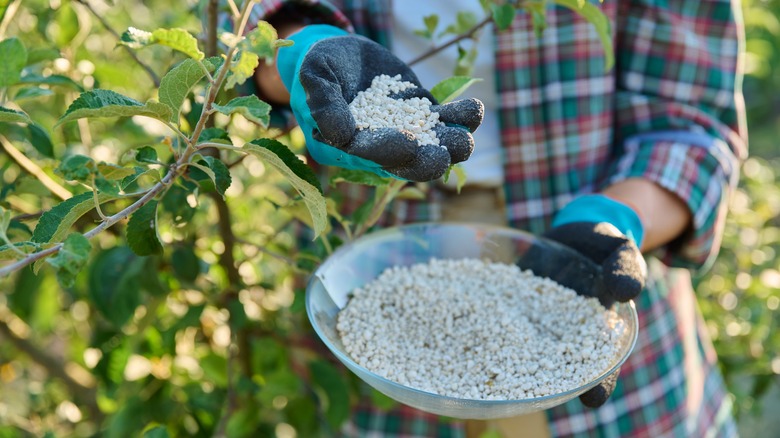One Reason Your Crepe Myrtle Tree Isn't Flowering (& Tips To Fix It)
The crepe myrtle (Lagerstroemia indica) is a stunning small deciduous tree that will delight you with masses of colorful blooms in summer. But, what if the gorgeous crepe myrtle in your garden just isn't flowering? The problem might be the type of nutrients that are available to the roots of your tree. In order to produce its eye-catching blooms, your crepe myrtle tree needs decent amounts of potassium and phosphorus, not just a bountiful supply of nitrogen. In fact, one reason why your crepe myrtle is not flowering is because it's receiving a lot of nitrogen and not enough of the other major nutrients.
Crepe myrtles are native to Japan, southern China, the Philippines, and Indochina. They thrive in sunny spots with moist but well-drained soil. Being deciduous, these trees will lose their leaves over winter but even during the cold winter days, your crepe myrtle will still stun you with its exfoliating bark that showcases the smooth trunk underneath in varying shades of brown and gray. The crepe myrtle is one of the best flowering trees that will bring romance to your yard. Many people will also plant a stunning crepe myrtle to make their yard a hummingbird magnet.
Understanding why your crepe myrtle is not flowering
If you have a crepe myrtle growing in the middle of your lawn and it's producing lots of green leaves in spring but no flowers, it's likely that the tree roots are absorbing the high-nitrogen fertilizer you're applying to your lawn to keep it green. While high-nitrogen fertilizers are ideal for keeping your lawn lush, they won't help your crepe myrtle to produce those glorious blooms that you're looking forward to each year. In order to produce blooms, flowering trees also need adequate amounts of potassium and phosphorus. These nutrients are often found in quite low doses of fertilizers recommended for lawns. If you take a look at the lawn fertilizer pack, you'll see the breakdown of the three major nutrients as something like 4-1-2. This means that the fertilizer has 4% nitrogen to 1% phosphorus and 2% potassium. You could even go one step further and do a soil test to determine the level of nitrogen, phosphorus, and potassium in the soil around your crepe myrtle tree. This will help you understand which of the primary nutrients is lacking in the soil.
To give you a basic understanding of what these major nutrients do for your tree, here's a simple explanation. Nitrogen is responsible for the lush green growth that you see when the tree comes out of dormancy in spring. Then, in order to start producing flowers, the tree needs fairly equal amounts of phosphorus and potassium.
How to promote flowering in your crepe myrtle
To fix the lack of blooms on your crepe myrtle, you need to make sure that you give the tree the nutrients that it needs. Ideally, you want to look for a fairly balanced fertilizer with an NPK ratio something like 8-8-8 or 10-10-10. Even a fertilizer with a ratio like 12-4-8 will work because it contains enough potassium and phosphorus to promote flowering. Apply this in spring just as the tree starts to produce buds, ideally before rain is expected. The rain will wash the fertilizer down into the soil so that it can be absorbed by the roots. If there's no rain in the forecast, just water the fertilizer in instead.
Another solution is to do the soil test that was recommended previously. If you do find that the soil around the tree already contains plenty of nitrogen, you can use other supplements to add the necessary phosphorus and potassium to the soil. Using bone meal is a good way to add phosphorus but it doesn't contain any potassium. The general NPK ratio of bone meal is 6-12-0. An even better alternative would be to use fish meal with a general ratio of 6-3-2 or seaweed extract with a ratio of 1-2-5. Now that you know how to fertilize your tree, you'll also want to know other care tips to ensure a healthy and thriving crepe myrtle tree.


